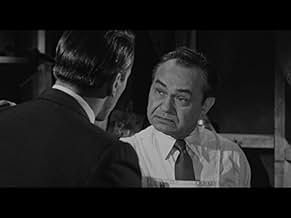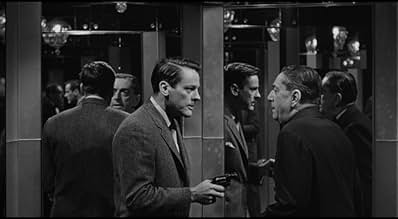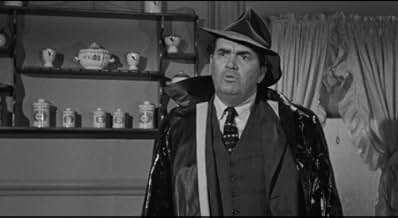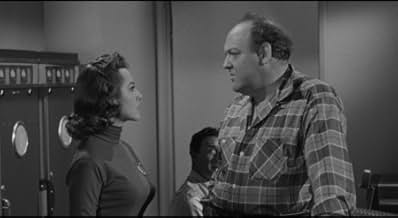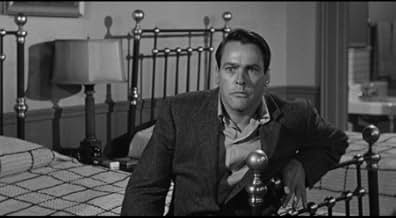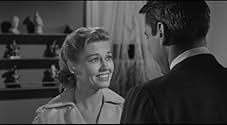IMDb-BEWERTUNG
6,4/10
1384
IHRE BEWERTUNG
Füge eine Handlung in deiner Sprache hinzuA New Orleans musician has a nightmare about killing a man in a strange house but he suspects that it really happened.A New Orleans musician has a nightmare about killing a man in a strange house but he suspects that it really happened.A New Orleans musician has a nightmare about killing a man in a strange house but he suspects that it really happened.
- Regie
- Drehbuch
- Hauptbesetzung
Ralph Brooks
- Oscar - the Bartender
- (Nicht genannt)
Jack Chefe
- Nightclub Waiter
- (Nicht genannt)
John Mitchum
- Onlooker at Stan's Suicide Attempt
- (Nicht genannt)
Cosmo Sardo
- Nightclub Patron
- (Nicht genannt)
Empfohlene Bewertungen
******SPOILERS****** Unbelievably heavy handed movie that telegraphs it's story to the audience so directly that you think it's a commercial for Western Union. Musician Stan Grayson, Kevin McCarthy, walks around most of the time in a zombie-like induced state and when he's conscious with his eyes bulging out of his head and looking like he's going into cardiac arrest at any moment that you want to run to the nearest phone and call 911 for help.
Waking up one morning at his room at the Hotel New Orleans from a nightmare that he had about him being a hall of mirrors and getting into a fight where he kills someone in self-defense Stan then opens a door and falls into a dark and bottomless pit. Stan looks in the mirror and sees marks on his throat and blood on his arm as well as having both a key and a button from the man's suit that was in his dream.
The movie tries to be both hip and cool when it comes to Stan's mental state and how it was manipulated by the killer Dr. Belknap/Harry Britten, Gage Clarke, in a pseudo/psychological manner that was very common in films about mental issues back in the 1940's and 50's but seeing it now it comes across as both silly and amateurish.
The movie also tries to make a big deal about the killer being a doctor who is an expert in psychological studies just by judging from the books that he has in his private library, but at the same time make him physically violent. He runs over his wife with a car and shoots it out with the police in order to kill him off at the end of the movie.
Edward G.Robinson, Det. Rene Bressard, is very good in the movie as Stan's brother in-law and New Orleans police detective. Rene at first suspects Stan of the murders but then, like a good detective should, when he sees where the evidence leads him realizes that there is more to the murders then what he at first thought.
Kevin McCarthy seems to overact in the movie, or better yet was over-directed, by passing out about a half dozen times and coming across as being brain-dead even when he wasn't under hypnosis. The movie tells the audience that you can't do anything under hypnosis that you won't do when your conscious like murder at the same time we see Stan being told to drown himself in the swamp by Dr. Belknap and then willingly do it.
Granted Stan tried to kill himself earlier in the film by jumping from the fifteen floor of the Hotel New Orleans but that was when he thought that he was a murderer. By the time he was told to drown himself he already knew that he didn't commit any murders so there was no conscious or subconscious reasons for him to do it. Stan was eventually saved from drowning by his brother in-law Rene.
Virginia Christine, Sue Bressard, was very good as Stan's sister and Rene's pregnant wife who developed a hearty appetite because of the condition that she was in and Gage Clarke, Dr. Belknap/ Harry Britten, was effective as the highly educated murderer. Connie Russell, Gina, as Stan's love interest had really nothing to do in the movie but stand around and look pretty, she did sing two songs.
The movie "Nightmare" can be forgiven for it's heavy handedness since it was the norm in movies about psychiatric issues back in those days, 1955, but at the same time can't be taken seriously by anyone watching it now in 2004.
Waking up one morning at his room at the Hotel New Orleans from a nightmare that he had about him being a hall of mirrors and getting into a fight where he kills someone in self-defense Stan then opens a door and falls into a dark and bottomless pit. Stan looks in the mirror and sees marks on his throat and blood on his arm as well as having both a key and a button from the man's suit that was in his dream.
The movie tries to be both hip and cool when it comes to Stan's mental state and how it was manipulated by the killer Dr. Belknap/Harry Britten, Gage Clarke, in a pseudo/psychological manner that was very common in films about mental issues back in the 1940's and 50's but seeing it now it comes across as both silly and amateurish.
The movie also tries to make a big deal about the killer being a doctor who is an expert in psychological studies just by judging from the books that he has in his private library, but at the same time make him physically violent. He runs over his wife with a car and shoots it out with the police in order to kill him off at the end of the movie.
Edward G.Robinson, Det. Rene Bressard, is very good in the movie as Stan's brother in-law and New Orleans police detective. Rene at first suspects Stan of the murders but then, like a good detective should, when he sees where the evidence leads him realizes that there is more to the murders then what he at first thought.
Kevin McCarthy seems to overact in the movie, or better yet was over-directed, by passing out about a half dozen times and coming across as being brain-dead even when he wasn't under hypnosis. The movie tells the audience that you can't do anything under hypnosis that you won't do when your conscious like murder at the same time we see Stan being told to drown himself in the swamp by Dr. Belknap and then willingly do it.
Granted Stan tried to kill himself earlier in the film by jumping from the fifteen floor of the Hotel New Orleans but that was when he thought that he was a murderer. By the time he was told to drown himself he already knew that he didn't commit any murders so there was no conscious or subconscious reasons for him to do it. Stan was eventually saved from drowning by his brother in-law Rene.
Virginia Christine, Sue Bressard, was very good as Stan's sister and Rene's pregnant wife who developed a hearty appetite because of the condition that she was in and Gage Clarke, Dr. Belknap/ Harry Britten, was effective as the highly educated murderer. Connie Russell, Gina, as Stan's love interest had really nothing to do in the movie but stand around and look pretty, she did sing two songs.
The movie "Nightmare" can be forgiven for it's heavy handedness since it was the norm in movies about psychiatric issues back in those days, 1955, but at the same time can't be taken seriously by anyone watching it now in 2004.
This One has an Interesting Pedigree.
It is a Remake of a Film-Noir, Fear in the Night (1946) from the same Director, the Prolific (mostly screenplays) Maxwell Shane. Everybody Endlessly compares the two Movies,
This is a Distinctive Noir, at the End of the Cycle and it is Remarkable because it includes almost every Film-Noir Trope starting with the Title. Obsessive Fans of the Genre could make a List.
The least Impressive thing about "Nightmare" is the Print. TCM, a stickler for finding the Best Available, showed a very Unimpressive Version that was Weak all around. The Contrast is "Grayish" and the Look is very Flat. That Visual Disappointment Aside, the Film reminds of the Great Style that was all but Forgotten by 1956.
Seemingly Filmed on a Very Low Budget, it still manages to Conjure Up the Atmosphere of True Film-Noir. The On-Location Footage on the Streets and Bayou are "Nightmarish". The Film feels Odd and Off-Beat adding to the Enjoyment.
The Cast lead by Edward G. Robinson and Kevin Mccarthy give the Movie Gravitas and the Story, by Cornell Woolrich, is Rich with Mysterious Happenings and Dreamlike Displays.
If every Reviewer on Earth hasn't Spoiled the Ending You will Undoubtedly have a Fun Time with this Mystery Movie.
Highly Recommended for Low-Budget Entertainment.
This 1956 Film-Noir shows just what Staying Power the Genre could Generate. The Conservative Fifties, with Very Few Exceptions, had Hollywood Capitulating to Government Gawking and Back-Room Intimidation and the Cynical and Edgy Film-Noir Genre was Relegated to Cheap Second Features and within a Year or two was Abandoned Altogether.
Making a Comeback about Later, as Neo-Noir, the Movies Started Experimenting with a Renewed Energy as things were Opening Up Culturally and the Art Form found that the Freedom to Express was again winning the Public's Imagination and Imagination is obviously one of the Ingredients in the Creative Process.
It is a Remake of a Film-Noir, Fear in the Night (1946) from the same Director, the Prolific (mostly screenplays) Maxwell Shane. Everybody Endlessly compares the two Movies,
This is a Distinctive Noir, at the End of the Cycle and it is Remarkable because it includes almost every Film-Noir Trope starting with the Title. Obsessive Fans of the Genre could make a List.
The least Impressive thing about "Nightmare" is the Print. TCM, a stickler for finding the Best Available, showed a very Unimpressive Version that was Weak all around. The Contrast is "Grayish" and the Look is very Flat. That Visual Disappointment Aside, the Film reminds of the Great Style that was all but Forgotten by 1956.
Seemingly Filmed on a Very Low Budget, it still manages to Conjure Up the Atmosphere of True Film-Noir. The On-Location Footage on the Streets and Bayou are "Nightmarish". The Film feels Odd and Off-Beat adding to the Enjoyment.
The Cast lead by Edward G. Robinson and Kevin Mccarthy give the Movie Gravitas and the Story, by Cornell Woolrich, is Rich with Mysterious Happenings and Dreamlike Displays.
If every Reviewer on Earth hasn't Spoiled the Ending You will Undoubtedly have a Fun Time with this Mystery Movie.
Highly Recommended for Low-Budget Entertainment.
This 1956 Film-Noir shows just what Staying Power the Genre could Generate. The Conservative Fifties, with Very Few Exceptions, had Hollywood Capitulating to Government Gawking and Back-Room Intimidation and the Cynical and Edgy Film-Noir Genre was Relegated to Cheap Second Features and within a Year or two was Abandoned Altogether.
Making a Comeback about Later, as Neo-Noir, the Movies Started Experimenting with a Renewed Energy as things were Opening Up Culturally and the Art Form found that the Freedom to Express was again winning the Public's Imagination and Imagination is obviously one of the Ingredients in the Creative Process.
I had a feeling of deja vu as I watched this, and I soon realized it was a remake of Fear in the Night, a 1947 film starring DeForrest Kelley.
This film stars Edward G. Robinson, Kevin McCarthy, Virginia Christine, Connie Russell.
A young New Orleans jazz musician Stan (McCarthy) dreams that he's involved in a murder. He wakes up holding a button, a key, and he has blood on him. He's convinced he committed murder without realizing it. He approaches his brother-in-law Rene (Robinson), a police detective, who brushes it off as a nightmare.
One day, while on a picnic, Stan, Rene, Rene's wife (Christine) and Stan's girlfriend Gina (Russell) are caught in a rainstorm. Without realizing how he knows, Stan directs them to a house. There's a mirrored room as in his dream, and the key fits a closet.
Rene realizes that somehow Stan was involved and accuses him of lying and demanding to know the whole story. Stan swears it was all a dream, and he doesn't know what happened. When the sheriff comes along and tells them there was a murder in the house, Rene wants more information, believing Stan is a killer.
Neat story by Cornell Woolrich, who wrote "Rear Window." Edward G. Robinson is great as always as a man determined to get to the bottom of the mystery.
Kevin McCarthy, who worked until he died at 96, is adorable in this.
Some fantastic singing by Connie Russell -- it's worth watching the film just to hear her -- in what would be her last film. After a long career on stage, films, and clubs on two continents, she retired when she became a mom.
Very entertaining. The end is wonderful, and really puts it a cut above "Fear in the Night."
This film stars Edward G. Robinson, Kevin McCarthy, Virginia Christine, Connie Russell.
A young New Orleans jazz musician Stan (McCarthy) dreams that he's involved in a murder. He wakes up holding a button, a key, and he has blood on him. He's convinced he committed murder without realizing it. He approaches his brother-in-law Rene (Robinson), a police detective, who brushes it off as a nightmare.
One day, while on a picnic, Stan, Rene, Rene's wife (Christine) and Stan's girlfriend Gina (Russell) are caught in a rainstorm. Without realizing how he knows, Stan directs them to a house. There's a mirrored room as in his dream, and the key fits a closet.
Rene realizes that somehow Stan was involved and accuses him of lying and demanding to know the whole story. Stan swears it was all a dream, and he doesn't know what happened. When the sheriff comes along and tells them there was a murder in the house, Rene wants more information, believing Stan is a killer.
Neat story by Cornell Woolrich, who wrote "Rear Window." Edward G. Robinson is great as always as a man determined to get to the bottom of the mystery.
Kevin McCarthy, who worked until he died at 96, is adorable in this.
Some fantastic singing by Connie Russell -- it's worth watching the film just to hear her -- in what would be her last film. After a long career on stage, films, and clubs on two continents, she retired when she became a mom.
Very entertaining. The end is wonderful, and really puts it a cut above "Fear in the Night."
Kevin McCarthy, a jazzman from New Orleans, has a nightmare. He dreams he was in a strange room and committed a murder, only to find out the next morning that there are clues he actually did it. Terrified, he goes to his brother-in-law (Edward G Robinson) to ask for help. Edward G doesn't believe him at first, but soon the evidence begins to pile up. The rest is too good to reveal. Kevin McCarthy's performance right on the heels of "Invasion of the Body Snatchers" is flawless - the terrified victim - again. Eddie G's character as the cynical, hard boiled homicide dick is one of his best. The story riveted me from start to finish and director Maxwell Shane set just the right tone. Watch for the final scenes in the mirrored room. The atmosphere shots of New Orleans in the 50's transports us back to another time. It's a mystery - a drama - a thriller. Do not miss it.
In the late 1940s, director Maxwell Shane made a very low budget psychological thriller called Fear in the Dark -- about a man waking from a nightmare that he's murdered a stranger, only to find it to be true. In 1956, Shane decided to remake it as Nightmare, with a name cast (Kevin McCarthy -- Mary's brother, for the record -- as the luckless dreamer, Edward G. Robinson as his brother-in-law the homicide cop). It's a very close remake, not as pointlessly literal as Gus Van Sant's cloning of Psycho, but with little changed except a better and more integrated jazz score. In sum, Nightmare boasts better acting and better production values, all of which serve to point up the basic cheesiness of the plot. The earlier version, looking a lot like a nightmare itself, lends its own low-rent integrity to Cornell Woolrich's bizarre vision.
Wusstest du schon
- WissenswertesWhen Stan goes out walking the morning after his nightmare, he passes by a place with a sign that says "New Orleans' Most Famous Coffee Drinking Place." That would be the Morning Call Coffee Stand that was on Decatur Street in the French Quarter. Opened in 1870, it moved to Metairie in 1974.
- PatzerAccording to the elevator there are only 15 floors in the hotel, but the shot of the building from outside shows more than fifteen.
- Zitate
[first lines]
Stan Grayson: At first, all I could see was this face, this beautiful babe's face, floating toward me. And in my head, was this slow, crazy melody - like a tune from another world. And then a I saw the room - a queer mirrored room. And somehow, I was inside of it. There was danger there. I knew that.
- VerbindungenFeatured in Out of this World Super Shock Show (2007)
- SoundtracksWhat's Your Sad Story
Words and Music by Richard M. Sherman (as Dick Sherman)
Performed by Connie Russell / Billy May Orchestra
Top-Auswahl
Melde dich zum Bewerten an und greife auf die Watchlist für personalisierte Empfehlungen zu.
- How long is Nightmare?Powered by Alexa
Details
- Laufzeit1 Stunde 29 Minuten
- Farbe
Zu dieser Seite beitragen
Bearbeitung vorschlagen oder fehlenden Inhalt hinzufügen


